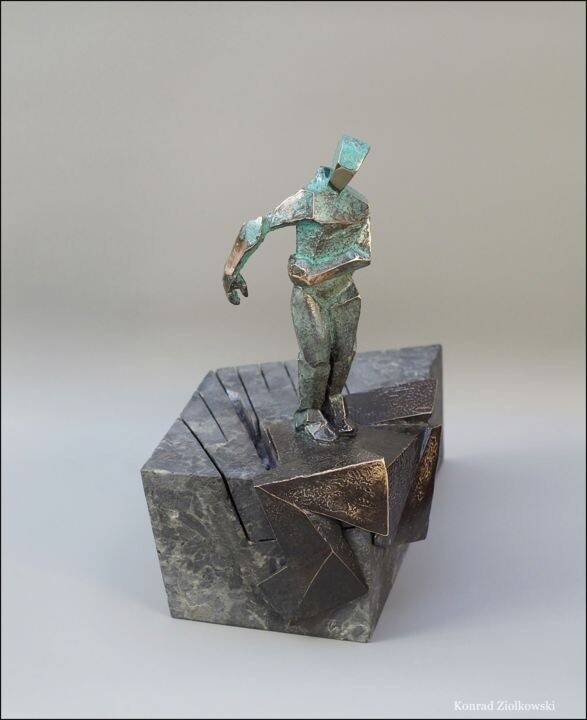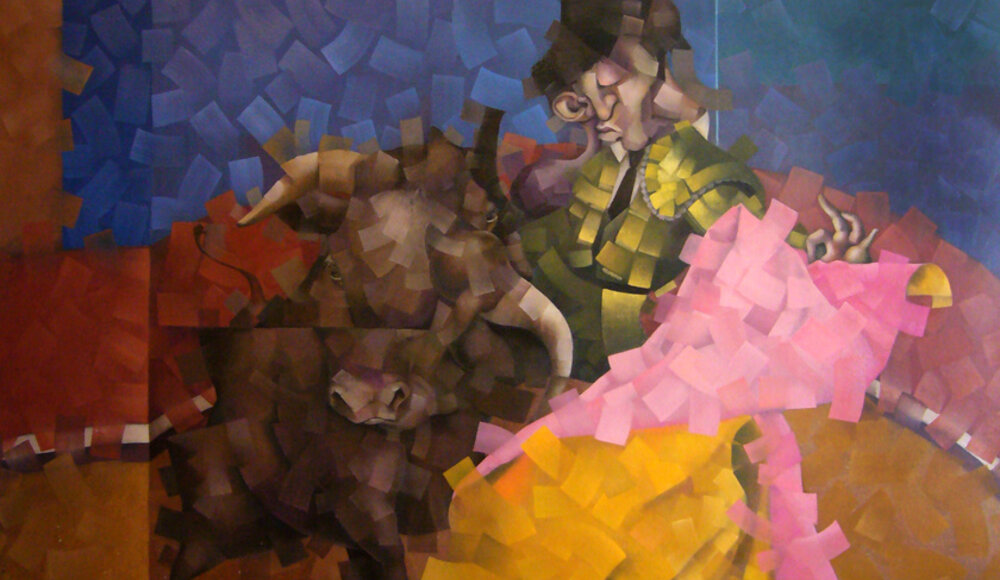 Carlos Blanco Artero, Bullfighting, 2014. Oil on canvas, 200 x 180 cm.
Carlos Blanco Artero, Bullfighting, 2014. Oil on canvas, 200 x 180 cm.
Brief reflections on the contemporary art world
The 20th century was rich in multiple artistic movements, trends and expressions, among which, it is impossible not to mention Cubism, Dadaism, Surrealism, Expressionism, Pop art, Conceptual Art and Minimalism. In comparison, the 21st century still turns out to be devoid of any form of significant artistic current, since, after the mythical Andy Warhol, artists have well thought to be wary of groups of a few self-declared elites, preferring a predominantly conceptual orientation, capable of bringing together even fundamentally different practices. In any case, with all their peculiarities, the artistic manifestations of our times make explicit reference to a prevailing "label," that of globalization, a phenomenon that has generated a vast creative world of difficult classification, aimed at revolving mainly around the "god" money. Nevertheless, the most famous movements of the twentieth century continue to enchant the world of contemporary art, within which artists often reinterpret stylistic features of it, which are to this day used to classify the same works of art. In this context, it is impossible not to think of Cubism, one of the most influential art movements of the twentieth century, which continues to make waves within today's art research.
 Georgi Demirev, Magical landscape II, 2022. Acrylic / pastel / pencil on MDF board, 63 x 79 cm.
Georgi Demirev, Magical landscape II, 2022. Acrylic / pastel / pencil on MDF board, 63 x 79 cm.
 Maria Tuzhilkina, Fresh kiwi, 2022. Acrylic on linen canvas, 50 x 50 cm.
Maria Tuzhilkina, Fresh kiwi, 2022. Acrylic on linen canvas, 50 x 50 cm.
Brief history of cubism
«The fact that for a long time Cubism has not been understood and that even today there are people who cannot see anything in it means nothing. I do not read English, an English book is a blank book to me. This does not mean that the English language does not exist. Why should I blame anyone but myself if I cannot understand what I know nothing about?»
Pablo Picasso's iconic, profound and decisive words are perfect for introducing to the concept of Cubism, an artistic movement based mainly on three ingredients: geometricity, simultaneity of multiple visions and the desire to render the "fourth dimension." All these components combine to generate an unprecedented worldview, since Cubism is, for all intents and purposes, a particular kind of "realism." It is possible to explain what has been said by giving a concrete example: the mouth of any vase turns out to be explicitly round to the eye, but, in order to capture it within a graphic perspective representation, it is often made as if it were oval. Cubism, on the other hand, would depict it as a circle, bringing it back to its simpler, yet real, essence. But how did this form of "revelation" of the most original nature of things come about? In 1907, the French painter Georges Braque, visiting the studio of his friend Pablo Picasso, located in the iconic Montmartre district (Paris), was literally overwhelmed by the sight of one of the Spanish master's greatest masterpieces, Les Demoiselles d'Avignon (1907). It is precisely to the peculiarities of this monumental canvas, marked by fractured geometric planes, mask-like faces and angular bodies, that the origins of the Cubist movement can be traced. In fact, after this vision Braque's painting took a new direction, which led him to create some "decomposed" landscapes, which art critic Louis Vauxcelles defined as being made through geometric cube-like patterns. The latter words, credited as the first use of the term cubes to describe this style of painting, are most likely responsible for the birth of the term cubism.
 Eugene Ivanov, Blue still-life, 2020. Oil on canvas, 60 x 60 cm.
Eugene Ivanov, Blue still-life, 2020. Oil on canvas, 60 x 60 cm.
 Jean Mirre, The cubist diary after Juan Gris, 2021. Oil / pencil on paper, 30 x 21 cm.
Jean Mirre, The cubist diary after Juan Gris, 2021. Oil / pencil on paper, 30 x 21 cm.
The different phases of Cubism
The first era of the movement, located between c. 1907 and 1912, is known as Analytical Cubism, a creative approach aimed at depicting representations of the same subject from several points of view at once, in which a fractured, multidimensional effect is created and expressed through a limited palette of colors. Later, and more specifically from 1912 onward, the phase of Synthetic Cubism took hold, during which Picasso and Braque began to incorporate words into paintings, intended to evolve into the elements of collages having brightly colored characters as their subject. Orphic Cubism, on the other hand, is a movement derived from the previous ones, which, well expressed by the work of the Puteaux Group collective, formed in 1913 by French painter Jacques Villon and his brother Raymond Duchamp-Villon, embraced even more vivid hues and increased abstraction. Finally, with the advent of World War I, Cubism suffered an arrest as an organized movement, in part because many of its members, including Braque, Lhote, de La Fresnaye, and Léger, were called into military service. Nonetheless, by 1917 the movement's stylistic features reappeared in some of Picasso's works, such as The Three Musicians (1921) and The Weeping Woman (1937), and in several of Braque's works.
 Konrad Ziolkowski, Grogis, 2019. Metal sculpture, 30 x 20 x 36cm / 8,00 kg.
Konrad Ziolkowski, Grogis, 2019. Metal sculpture, 30 x 20 x 36cm / 8,00 kg.
Cubism in Artmajeur's artworks
Just as anticipated, Cubism turns out to be one of the 20th-century Avant-gardes to have been most successful in the 21st century, a fact largely found within the Artmajeur database as well, where there are multiple works of art in line with the stylistic features of the aforementioned movement. Perfect to exemplify such popularity are the paintings and sculptures of Aket, Martine Camors and Corinne Raynal, which are strongly marked by geometricity, simultaneity of multiple visions and a desire to render the "fourth dimension."
 Aket, Piano piano, 2022. Acrylic on canvas, 61 x 50 cm.
Aket, Piano piano, 2022. Acrylic on canvas, 61 x 50 cm.
Aket: Piano piano
Aket's painting, depicting a pianist gathered at the height of his creative impetus, interprets, in a totally original and innovative way, the stylistic features of Cubism, which are concentrated, in particular, in the somatic features, the hair and the perspective rendering of the effigy's pipe. In addition, the lackluster and sparse chromaticism, reduced exclusively to shades of purple, gray, and black, with a few touches of yellow, most likely echoes the purest intent of Synthetic Cubism, that is, to use a narrow range of colors in order to avoid disturbing elements for the artist and the viewer, whose goal is to analyze and investigate the rendering of the real datum. On the other hand, regarding the theme addressed, it turns out to be a "cult" of the Cubist movement, since it was already addressed by the great master Picasso in the well-known painting entitled The Three Musicians (1921).
 Martine Camors, Têtê à têtê, 2010. Bronze sculpture, 45 x 30 x 12 cm / 9.50 kg.
Martine Camors, Têtê à têtê, 2010. Bronze sculpture, 45 x 30 x 12 cm / 9.50 kg.
Martine Camors: Têtê à têtê
Martine Camors' bronze sculpture depicts a "decomposed," "fragmented," extremely geometric half-bust of a woman concealed behind a "mask." In fact, the face of the effigy is reminiscent of that of the protagonists of Les Demoiselles d'Avignon, a masterpiece that Picasso executed while also referencing the customs of African tradition. In addition, the Spanish artist inherited from the latter the immediacy, simplicity and synthesis of forms, often constructed through the use of geometric figures. Returning to the sculpture of the artist from Artmajeur, it also brings us back to the work of other well-known masters, such as Alexander Archipenko, a great example for the way of decomposing the human face, and Henri Laurens, a point of reference for the geometric language. In particular, it is possible to compare Têtê à têtê with two masterpieces by the aforementioned artists, namely Head - Self-Portrait (1913) and Femme au Compotier (1920).
 Corinne Raynal, Sylvie, 2019. Oil on linen canvas, 80 x 80 cm.
Corinne Raynal, Sylvie, 2019. Oil on linen canvas, 80 x 80 cm.
Corinne Raynal: Sylvie
Corinne Raynal's oil painting fits perfectly into the stylistic features, colors and subjects investigated by Cubism, in that the work, created through sharp sections of color, is reminiscent, albeit in a very original way, of Jean Metzinger's iconic Two Nudes. In the latter painting, akin to Sylvie in theme and "palette," the French master immortalized the human body, trees, and rocks in exactly the same way. Following his example, the Artmajeur artist depicted the protagonist of his work by immersing her in a background in which she herself blends like a chameleon. Finally, it is worth highlighting how Metzinger's masterpiece is also legendary because it was exhibited at the first Cubist manifestation in history, namely the 1911 Salon des Indépendants in Paris, an event that consecrated the movement to the general public. Consequently, Corinne Raynal's work, akin to Two Nudes, could represent a hypothetical new "manifesto" of contemporary Cubism, the result of a fusion of tradition and innovation.


 Olimpia Gaia Martinelli
Olimpia Gaia Martinelli























